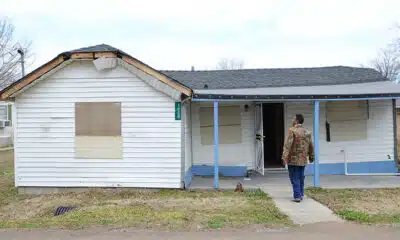Kaiser Health News
Tribal Nations Invest Opioid Settlement Funds in Traditional Healing to Treat Addiction
Aneri Pattani and Jazmin Orozco Rodriguez
Wed, 15 May 2024 09:00:00 +0000
PRESQUE ISLE, Maine — Outside the Mi’kmaq Nation’s health department sits a dome-shaped tent, built by hand from saplings and covered in black canvas. It’s one of several sweat lodges on the tribe’s land, but this one is dedicated to helping people recover from addiction.
Up to 10 people enter the lodge at once. Fire-heated stones — called grandmothers and grandfathers, for the spirits they represent — are brought inside. Water is splashed on the stones, and the lodge fills with steam. It feels like a sauna, but hotter. The air is thicker, and it’s dark. People pray and sing songs. When they leave the lodge, it is said, they reemerge from the mother’s womb. Cleansed. Reborn.
The experience can be “a vital tool” in healing, said Katie Espling, health director for the roughly 2,000-member tribe.
She said patients in recovery have requested sweat lodges for years as a cultural element to complement the counseling and medications the tribe’s health department already provides. But insurance doesn’t cover sweat ceremonies, so, until now, the department couldn’t afford to provide them.
In the past year, the Mi’kmaq Nation received more than $150,000 from settlements with companies that made or sold prescription painkillers and were accused of exacerbating the overdose crisis. A third of that money was spent on the sweat lodge.
Health care companies are paying out more than $1.5 billion to hundreds of tribes over 15 years. This windfall is similar to settlements that many of the same companies are paying to state governments, which total about $50 billion.
To some people, the lower payout for tribes corresponds to their smaller population. But some tribal citizens point out that the overdose crisis has had a disproportionate effect on their communities. Native Americans had the highest overdose death rates of any racial group each year from 2020 to 2022. And federal officials say those statistics were likely undercounted by about 34% because Native Americans’ race is often misclassified on death certificates.
Still, many tribal leaders are grateful for the settlements and the unique way the money can be spent: Unlike the state payments, money sent to tribes can be used for traditional and cultural healing practices — anything from sweat lodges and smudging ceremonies to basketmaking and programs that teach tribal languages.
“To have these dollars to do that, it’s really been a gift,” said Espling of the Mi’kmaq tribe. “This is going to absolutely be fundamental to our patients’ well-being” because connecting with their culture is “where they’ll really find the deepest healing.”
Public health experts say the underlying cause of addiction in many tribal communities is intergenerational trauma, resulting from centuries of brutal treatment, including broken treaties, land theft, and a government-funded boarding school system that sought to erase the tribes’ languages and cultures. Along with a long-running lack of investment in the Indian Health Service, these factors have led to lower life expectancy and higher rates of addiction, suicide, and chronic diseases.
Using settlement money to connect tribal citizens with their traditions and reinvigorate pride in their culture can be a powerful healing tool, said Andrea Medley, a researcher with the Johns Hopkins Center for Indigenous Health and a member of the Haida Nation. She helped create principles for how tribes can consider spending settlement money.
Medley said that having respect for those traditional elements outlined explicitly in the settlements is “really groundbreaking.”
‘A Drop in the Bucket’
Of the 574 federally recognized tribes, more than 300 have received payments so far, totaling more than $371 million, according to Kevin Washburn, one of three court-appointed directors overseeing the tribal settlements.
Although that sounds like a large sum, it pales in comparison with what the addiction crisis has cost tribes. There are also hundreds of tribes that are excluded from the payments because they aren’t federally recognized.
“These abatement funds are like a drop in the bucket compared to what they’ve spent, compared to what they anticipate spending,” said Corey Hinton, a lawyer who represented several tribes in the opioid litigation and a citizen of the Passamaquoddy Tribe. “Abatement is a cheap term when we’re talking about a crisis that is still engulfing and devastating communities.”
Even leaders of the Navajo Nation — the largest federally recognized tribe in the United States, which has received $63 million so far — said the settlements can’t match the magnitude of the crisis.
“It’ll do a little dent, but it will only go so far,” said Kim Russell, executive director of the Navajo Department of Health.
The Navajo Nation is trying to stretch the money by using it to improve its overall health system. Officials plan to use the payouts to hire more coding and billing employees for tribe-operated hospitals and clinics. Those workers would help ensure reimbursements keep flowing to the health systems and would help sustain and expand services, including addiction treatment and prevention, Russell said.
Navajo leaders also want to hire more clinicians specializing in substance use treatment, as well as primary care doctors, nurses, and epidemiologists.
“Building buildings is not what we want” from the opioid settlement funds, Russell said. “We’re nation-building.”
High Stakes for Small Tribes
Smaller nations like the Poarch Band of Creek Indians in southern Alabama are also strategizing to make settlement money go further.
For the tribe of roughly 2,900 members, that has meant investing $500,000 — most of what it has received so far — into a statistical modeling platform that its creators say will simulate the opioid crisis, predict which programs will save the most lives, and help local officials decide the most effective use of future settlement cash.
Some recovery advocates have questioned the model’s value, but the tribe’s vice chairman, Robert McGhee, said it would provide the data and evidence needed to choose among efforts competing for resources, such as recovery housing or peer support specialists. The tribe wants to do both, but realistically, it will have to prioritize.
“If we can have this model and we put the necessary funds to it and have the support, it’ll work for us,” McGhee said. “I just feel it in my gut.”
The stakes are high. In smaller communities, each death affects the whole tribe, McGhee said. The loss of one leader marks decades of lost knowledge. The passing of a speaker means further erosion of the Native language.
For Keesha Frye, who oversees the Poarch Band of Creek Indians’ tribal court and the sober living facility, using settlement money effectively is personal. “It means a lot to me to get this community well because this is where I live and this is where my family lives,” she said.
Erik Lamoreau in Maine also brings personal ties to this work. More than a decade ago, he sold drugs on Mi’kmaq lands to support his own addiction.
“I did harm in this community and it was really important for me to come back and try to right some of those wrongs,” Lamoreau said.
Today, he works for the tribe as a peer recovery coordinator, a new role created with the opioid settlement funds. He uses his experience to connect with others and help them with recovery — whether that means giving someone a ride to court, working on their résumé, exercising together at the gym, or hosting a cribbage club, where people play the card game and socialize without alcohol or drugs.
Beginning this month, Lamoreau’s work will also involve connecting clients who seek cultural elements of recovery to the new sweat lodge service — an effort he finds promising.
“The more in tune you are with your culture — no matter what culture that is — it connects you to something bigger,” Lamoreau said. “And that’s really what we look at when we’re in recovery, when we talk about spiritual connection. It’s something bigger than you.”
——————————
By: Aneri Pattani and Jazmin Orozco Rodriguez
Title: Tribal Nations Invest Opioid Settlement Funds in Traditional Healing to Treat Addiction
Sourced From: kffhealthnews.org/news/article/tribal-nations-opioid-settlement-funds-cultural-traditional-healing/
Published Date: Wed, 15 May 2024 09:00:00 +0000
Did you miss our previous article…
https://www.biloxinewsevents.com/after-a-childs-death-california-weighs-rules-for-phys-ed-during-extreme-weather/
Kaiser Health News
Dual Threats From Trump and GOP Imperil Nursing Homes and Their Foreign-Born Workers
In a top-rated nursing home in Alexandria, Virginia, the Rev. Donald Goodness is cared for by nurses and aides from various parts of Africa. One of them, Jackline Conteh, a naturalized citizen and nurse assistant from Sierra Leone, bathes and helps dress him most days and vigilantly intercepts any meal headed his way that contains gluten, as Goodness has celiac disease.
“We are full of people who come from other countries,” Goodness, 92, said about Goodwin House Alexandria’s staff. Without them, the retired Episcopal priest said, “I would be, and my building would be, desolate.”
The long-term health care industry is facing a double whammy from President Donald Trump’s crackdown on immigrants and the GOP’s proposals to reduce Medicaid spending. The industry is highly dependent on foreign workers: More than 800,000 immigrants and naturalized citizens comprise 28% of direct care employees at home care agencies, nursing homes, assisted living facilities, and other long-term care companies.
But in January, the Trump administration rescinded former President Joe Biden’s 2021 policy that protected health care facilities from Immigration and Customs Enforcement raids. The administration’s broad immigration crackdown threatens to drastically reduce the number of current and future workers for the industry. “People may be here on a green card, and they are afraid ICE is going to show up,” said Katie Smith Sloan, president of LeadingAge, an association of nonprofits that care for older adults.
Existing staffing shortages and quality-of-care problems would be compounded by other policies pushed by Trump and the Republican-led Congress, according to nursing home officials, resident advocates, and academic experts. Federal spending cuts under negotiation may strip nursing homes of some of their largest revenue sources by limiting ways states leverage Medicaid money and making it harder for new nursing home residents to retroactively qualify for Medicaid. Care for 6 in 10 residents is paid for by Medicaid, the state-federal health program for poor or disabled Americans.
“We are facing the collision of two policies here that could further erode staffing in nursing homes and present health outcome challenges,” said Eric Roberts, an associate professor of internal medicine at the University of Pennsylvania.
The industry hasn’t recovered from covid-19, which killed more than 200,000 long-term care facility residents and workers and led to massive staff attrition and turnover. Nursing homes have struggled to replace licensed nurses, who can find better-paying jobs at hospitals and doctors’ offices, as well as nursing assistants, who can earn more working at big-box stores or fast-food joints. Quality issues that preceded the pandemic have expanded: The percentage of nursing homes that federal health inspectors cited for putting residents in jeopardy of immediate harm or death has risen alarmingly from 17% in 2015 to 28% in 2024.
In addition to seeking to reduce Medicaid spending, congressional Republicans have proposed shelving the biggest nursing home reform in decades: a Biden-era rule mandating minimum staffing levels that would require most of the nation’s nearly 15,000 nursing homes to hire more workers.
The long-term care industry expects demand for direct care workers to burgeon with an influx of aging baby boomers needing professional care. The Census Bureau has projected the number of people 65 and older would grow from 63 million this year to 82 million in 2050.
In an email, Vianca Rodriguez Feliciano, a spokesperson for the Department of Health and Human Services, said the agency “is committed to supporting a strong, stable long-term care workforce” and “continues to work with states and providers to ensure quality care for older adults and individuals with disabilities.” In a separate email, Tricia McLaughlin, a Department of Homeland Security spokesperson, said foreigners wanting to work as caregivers “need to do that by coming here the legal way” but did not address the effect on the long-term care workforce of deportations of classes of authorized immigrants.
Goodwin Living, a faith-based nonprofit, runs three retirement communities in northern Virginia for people who live independently, need a little assistance each day, have memory issues, or require the availability of around-the-clock nurses. It also operates a retirement community in Washington, D.C. Medicare rates Goodwin House Alexandria as one of the best-staffed nursing homes in the country. Forty percent of the organization’s 1,450 employees are foreign-born and are either seeking citizenship or are already naturalized, according to Lindsay Hutter, a Goodwin spokesperson.
“As an employer, we see they stay on with us, they have longer tenure, they are more committed to the organization,” said Rob Liebreich, Goodwin’s president and CEO.
Jackline Conteh spent much of her youth shuttling between Sierra Leone, Liberia, and Ghana to avoid wars and tribal conflicts. Her mother was killed by a stray bullet in her home country of Liberia, Conteh said. “She was sitting outside,” Conteh, 56, recalled in an interview.
Conteh was working as a nurse in a hospital in Sierra Leone in 2009 when she learned of a lottery for visas to come to the United States. She won, though she couldn’t afford to bring her husband and two children along at the time. After she got a nursing assistant certification, Goodwin hired her in 2012.
Conteh said taking care of elders is embedded in the culture of African families. When she was 9, she helped feed and dress her grandmother, a job that rotated among her and her sisters. She washed her father when he was dying of prostate cancer. Her husband joined her in the United States in 2017; she cares for him because he has heart failure.
“Nearly every one of us from Africa, we know how to care for older adults,” she said.
Her daughter is now in the United States, while her son is still in Africa. Conteh said she sends money to him, her mother-in-law, and one of her sisters.
In the nursing home where Goodness and 89 other residents live, Conteh helps with daily tasks like dressing and eating, checks residents’ skin for signs of swelling or sores, and tries to help them avoid falling or getting disoriented. Of 102 employees in the building, broken up into eight residential wings called “small houses” and a wing for memory care, at least 72 were born abroad, Hutter said.
Donald Goodness grew up in Rochester, New York, and spent 25 years as rector of The Church of the Ascension in New York City, retiring in 1997. He and his late wife moved to Alexandria to be closer to their daughter, and in 2011 they moved into independent living at the Goodwin House. In 2023 he moved into one of the skilled nursing small houses, where Conteh started caring for him.
“I have a bad leg and I can’t stand on it very much, or I’d fall over,” he said. “She’s in there at 7:30 in the morning, and she helps me bathe.” Goodness said Conteh is exacting about cleanliness and will tell the housekeepers if his room is not kept properly.
Conteh said Goodness was withdrawn when he first arrived. “He don’t want to come out, he want to eat in his room,” she said. “He don’t want to be with the other people in the dining room, so I start making friends with him.”
She showed him a photo of Sierra Leone on her phone and told him of the weather there. He told her about his work at the church and how his wife did laundry for the choir. The breakthrough, she said, came one day when he agreed to lunch with her in the dining room. Long out of his shell, Goodness now sits on the community’s resident council and enjoys distributing the mail to other residents on his floor.
“The people that work in my building become so important to us,” Goodness said.
While Trump’s 2024 election campaign focused on foreigners here without authorization, his administration has broadened to target those legally here, including refugees who fled countries beset by wars or natural disasters. This month, the Department of Homeland Security revoked the work permits for migrants and refugees from Cuba, Haiti, Nicaragua, and Venezuela who arrived under a Biden-era program.
“I’ve just spent my morning firing good, honest people because the federal government told us that we had to,” Rachel Blumberg, president of the Toby & Leon Cooperman Sinai Residences of Boca Raton, a Florida retirement community, said in a video posted on LinkedIn. “I am so sick of people saying that we are deporting people because they are criminals. Let me tell you, they are not all criminals.”
At Goodwin House, Conteh is fearful for her fellow immigrants. Foreign workers at Goodwin rarely talk about their backgrounds. “They’re scared,” she said. “Nobody trusts anybody.” Her neighbors in her apartment complex fled the U.S. in December and returned to Sierra Leone after Trump won the election, leaving their children with relatives.
“If all these people leave the United States, they go back to Africa or to their various countries, what will become of our residents?” Conteh asked. “What will become of our old people that we’re taking care of?”
KFF Health News is a national newsroom that produces in-depth journalism about health issues and is one of the core operating programs at KFF—an independent source of health policy research, polling, and journalism. Learn more about KFF.
Subscribe to KFF Health News’ free Morning Briefing.
This article first appeared on KFF Health News and is republished here under a Creative Commons license.
The post Dual Threats From Trump and GOP Imperil Nursing Homes and Their Foreign-Born Workers appeared first on kffhealthnews.org
Note: The following A.I. based commentary is not part of the original article, reproduced above, but is offered in the hopes that it will promote greater media literacy and critical thinking, by making any potential bias more visible to the reader –Staff Editor.
Political Bias Rating: Center-Left
This content primarily highlights concerns about the impact of restrictive immigration policies and Medicaid spending cuts proposed by the Trump administration and Republican lawmakers on the long-term care industry. It emphasizes the importance of immigrant workers in healthcare, the challenges that staffing shortages pose to patient care, and the potential negative effects of GOP policy proposals. The tone is critical of these policies while sympathetic toward immigrant workers and advocates for maintaining or increasing government support for healthcare funding. The framing aligns with a center-left perspective, focusing on social welfare, immigrant rights, and concern about the consequences of conservative economic and immigration policies without descending into partisan rhetoric.
Kaiser Health News
California’s Much-Touted IVF Law May Be Delayed Until 2026, Leaving Many in the Lurch
California lawmakers are poised to delay the state’s much-ballyhooed new law mandating in vitro fertilization insurance coverage for millions, set to take effect July 1. Gov. Gavin Newsom has asked lawmakers to push the implementation date to January 2026, leaving patients, insurers, and employers in limbo.
The law, SB 729, requires state-regulated health plans offered by large employers to cover infertility diagnosis and treatment, including IVF. Nine million people will qualify for coverage under the law. Advocates have praised the law as “a major win for Californians,” especially in making same-sex couples and aspiring single parents eligible, though cost concerns limited the mandate’s breadth.
People who had been planning fertility care based on the original timeline are now “left in a holding pattern facing more uncertainty, financial strain, and emotional distress,” Alise Powell, a director at Resolve: The National Infertility Association, said in a statement.
During IVF, a patient’s eggs are retrieved, combined with sperm in a lab, and then transferred to a person’s uterus. A single cycle can total around $25,000, out of reach for many. The California law requires insurers to cover up to three egg retrievals and an unlimited number of embryo transfers.
Not everyone’s coverage would be affected by the delay. Even if the law took effect July 1, it wouldn’t require IVF coverage to start until the month an employer’s contract renews with its insurer. Rachel Arrezola, a spokesperson for the California Department of Managed Health Care, said most of the employers subject to the law renew their contracts in January, so their employees would not be affected by a delay.
She declined to provide data on the percentage of eligible contracts that renew in July or later, which would mean those enrollees wouldn’t get IVF coverage until at least a full year from now, in July 2026 or later.
The proposed new implementation date comes amid heightened national attention on fertility coverage. California is now one of 15 states with an IVF mandate, and in February, President Donald Trump signed an executive order seeking policy recommendations to expand IVF access.
It’s the second time Newsom has asked lawmakers to delay the law. When the Democratic governor signed the bill in September, he asked the legislature to consider delaying implementation by six months. The reason, Newsom said then, was to allow time to reconcile differences between the bill and a broader effort by state regulators to include IVF and other fertility services as an essential health benefit, which would require the marketplace and other individual and small-group plans to provide the coverage.
Newsom spokesperson Elana Ross said the state needs more time to provide guidance to insurers on specific services not addressed in the law to ensure adequate and uniform coverage. Arrezola said embryo storage and donor eggs and sperm were examples of services requiring more guidance.
State Sen. Caroline Menjivar, a Democrat who authored the original IVF mandate, acknowledged a delay could frustrate people yearning to expand their families, but requested patience “a little longer so we can roll this out right.”
Sean Tipton, a lobbyist for the American Society for Reproductive Medicine, contended that the few remaining questions on the mandate did not warrant a long delay.
Lawmakers appear poised to advance the delay to a vote by both houses of the legislature, likely before the end of June. If a delay is approved and signed by the governor, the law would immediately be paused. If this does not happen before July 1, Arrezola said, the Department of Managed Health Care would enforce the mandate as it exists. All plans were required to submit compliance filings to the agency by March. Arrezola was unable to explain what would happen to IVF patients whose coverage had already begun if the delay passes after July 1.
The California Association of Health Plans, which opposed the mandate, declined to comment on where implementation efforts stand, although the group agrees that insurers need more guidance, spokesperson Mary Ellen Grant said.
Kaiser Permanente, the state’s largest insurer, has already sent employers information they can provide to their employees about the new benefit, company spokesperson Kathleen Chambers said. She added that eligible members whose plans renew on or after July 1 would have IVF coverage if implementation of the law is not delayed.
Employers and some fertility care providers appear to be grappling over the uncertainty of the law’s start date. Amy Donovan, a lawyer at insurance brokerage and consulting firm Keenan & Associates, said the firm has fielded many questions from employers about the possibility of delay. Reproductive Science Center and Shady Grove Fertility, major clinics serving different areas of California, posted on their websites that the IVF mandate had been delayed until January 2026, which is not yet the case. They did not respond to requests for comment.
Some infertility patients confused over whether and when they will be covered have run out of patience. Ana Rios and her wife, who live in the Central Valley, had been trying to have a baby for six years, dipping into savings for each failed treatment. Although she was “freaking thrilled” to learn about the new law last fall, Rios could not get clarity from her employer or health plan on whether she was eligible for the coverage and when it would go into effect, she said. The couple decided to go to Mexico to pursue cheaper treatment options.
“You think you finally have a helping hand,” Rios said of learning about the law and then, later, the requested delay. “You reach out, and they take it back.”
This article was produced by KFF Health News, which publishes California Healthline, an editorially independent service of the California Health Care Foundation.
KFF Health News is a national newsroom that produces in-depth journalism about health issues and is one of the core operating programs at KFF—an independent source of health policy research, polling, and journalism. Learn more about KFF.
USE OUR CONTENT
This story can be republished for free (details).
KFF Health News is a national newsroom that produces in-depth journalism about health issues and is one of the core operating programs at KFF—an independent source of health policy research, polling, and journalism. Learn more about KFF.
Subscribe to KFF Health News’ free Morning Briefing.
This article first appeared on KFF Health News and is republished here under a Creative Commons license.
The post California’s Much-Touted IVF Law May Be Delayed Until 2026, Leaving Many in the Lurch appeared first on kffhealthnews.org
Note: The following A.I. based commentary is not part of the original article, reproduced above, but is offered in the hopes that it will promote greater media literacy and critical thinking, by making any potential bias more visible to the reader –Staff Editor.
Political Bias Rating: Center-Left
This content is presented in a factual, balanced manner typical of center-left public policy reporting. It focuses on a progressive healthcare issue (mandated IVF insurance coverage) favorably highlighting benefits for diverse family structures and individuals, including same-sex couples and single parents, which often aligns with center-left values. At the same time, it includes perspectives from government officials, industry representatives, opponents, and patients, offering a nuanced view without overt ideological framing or partisan rhetoric. The emphasis on healthcare access, social equity, and patient impact situates the coverage within a center-left orientation.
Kaiser Health News
Push To Move OB-GYN Exam Out of Texas Is Piece of AGs’ Broader Reproductive Rights Campaign
Democratic state attorneys general led by those from California, New York, and Massachusetts are pressuring medical professional groups to defend reproductive rights, including medication abortion, emergency abortions, and travel between states for health care in response to recent increases in the number of abortion bans.
The American Medical Association adopted a formal position June 9 recommending that medical certification exams be moved out of states with restrictive abortion policies or made virtual, after 20 attorneys general petitioned to protect physicians who fear legal repercussions because of their work. The petition focused on the American Board of Obstetrics and Gynecology’s certification exams in Dallas, and the subsequent AMA recommendation was hailed as a win for Democrats trying to regain ground after the fall of Roe v. Wade.
“It seems incremental, but there are so many things that go into expanding and maintaining access to care,” said Arneta Rogers, executive director of the Center on Reproductive Rights and Justice at the University of California-Berkeley’s law school. “We see AGs banding together, governors banding together, as advocates work on the ground. That feels somewhat more hopeful — that people are thinking about a coordinated strategy.”
Since the Supreme Court eliminated the constitutional right to an abortion in 2022, 16 states, including Texas, have implemented laws banning abortion almost entirely, and many of them impose criminal penalties on providers as well as options to sue doctors. More than 25 states restrict access to gender-affirming care for trans people, and six of them make it a felony to provide such care to youth.
That’s raised concern among some physicians who fear being charged if they go to those states, even if their home state offers protection to provide reproductive and gender-affirming health care.
Pointing to the recent fining and indictment of a physician in New York who allegedly provided abortion pills to a woman in Texas and a teen in Louisiana, a coalition of physicians wrote in a letter to the American Board of Obstetrics and Gynecology that “the limits of shield laws are tenuous” and that “Texas laws can affect physicians practicing outside of the state as well.”
The campaign was launched by several Democratic attorneys general, including Rob Bonta of California, Andrea Joy Campbell of Massachusetts, and Letitia James of New York, who each have established a reproductive rights unit as a bulwark for their state following the Dobbs decision.
“Reproductive health care and gender-affirming care providers should not have to risk their safety or freedom just to advance in their medical careers,” James said in a statement. “Forcing providers to travel to states that have declared war on reproductive freedom and LGBTQ+ rights is as unnecessary as it is dangerous.”
In their petition, the attorneys general included a letter from Joseph Ottolenghi, medical director at Choices Women’s Medical Center in New York City, who was denied his request to take the test remotely or outside of Texas. To be certified by the American Board of Obstetrics and Gynecology, physicians need to take the in-person exam at its testing facility in Dallas. The board completed construction of its new testing facility last year.
“As a New York practitioner, I have made every effort not to violate any other state’s laws, but the outer contours of these draconian laws have not been tested or clarified by the courts,” Ottolenghi wrote.
Rachel Rebouché, the dean of Temple University’s law school and a reproductive law scholar, said “putting the heft” of the attorneys general behind this effort helps build awareness and a “public reckoning” on behalf of providers. Separately, some doctors have urged medical conferences to boycott states with abortion bans.
Anti-abortion groups, however, see the campaign as forcing providers to conform to abortion-rights views. Donna Harrison, an OB-GYN and the director of research at the American Association of Pro-Life Obstetricians and Gynecologists, described the petition as an “attack not only on pro-life states but also on life-affirming medical professionals.”
Harrison said the “OB-GYN community consists of physicians with values that are as diverse as our nation’s state abortion laws,” and that this diversity “fosters a medical environment of debate and rigorous thought leading to advancements that ultimately serve our patients.”
The AMA’s new policy urges specialty medical boards to host exams in states without restrictive abortion laws, offer the tests remotely, or provide exemptions for physicians. However, the decision to implement any changes to the administration of these exams is up to those boards. There is no deadline for a decision to be made.
The OB-GYN board did not respond to requests for comment, but after the public petition from the attorneys general criticizing it for refusing exam accommodations, the board said that in-person exams conducted at its national center in Dallas “provide the most equitable, fair, secure, and standardized assessment.”
The OB-GYN board emphasized that Texas’ laws apply to doctors licensed in Texas and to medical care within Texas, specifically. And it noted that its exam dates are kept under wraps, and that there have been “no incidents of harm to candidates or examiners across thousands of in-person examinations.”
Democratic state prosecutors, however, warned in their petition that the “web of confusing and punitive state-based restrictions creates a legal minefield for medical providers.” Texas is among the states that have banned doctors from providing gender-affirming care to transgender youth, and it has reportedly made efforts to get records from medical facilities and professionals in other states who may have provided that type of care to Texans.
The Texas attorney general’s office did not respond to requests for comment.
States such as California and New York have laws to block doctors from being extradited under other states’ laws and to prevent sharing evidence against them. But instances that require leveraging these laws could still mean lengthy legal proceedings.
“We live in a moment where we’ve seen actions by executive bodies that don’t necessarily square with what we thought the rules provided,” Rebouché said.
This article was produced by KFF Health News, which publishes California Healthline, an editorially independent service of the California Health Care Foundation.
KFF Health News is a national newsroom that produces in-depth journalism about health issues and is one of the core operating programs at KFF—an independent source of health policy research, polling, and journalism. Learn more about KFF.
USE OUR CONTENT
This story can be republished for free (details).
KFF Health News is a national newsroom that produces in-depth journalism about health issues and is one of the core operating programs at KFF—an independent source of health policy research, polling, and journalism. Learn more about KFF.
Subscribe to KFF Health News’ free Morning Briefing.
This article first appeared on KFF Health News and is republished here under a Creative Commons license.
The post Push To Move OB-GYN Exam Out of Texas Is Piece of AGs’ Broader Reproductive Rights Campaign appeared first on kffhealthnews.org
Note: The following A.I. based commentary is not part of the original article, reproduced above, but is offered in the hopes that it will promote greater media literacy and critical thinking, by making any potential bias more visible to the reader –Staff Editor.
Political Bias Rating: Center-Left
The article presents a viewpoint largely aligned with progressive and Democratic positions on reproductive rights and gender-affirming care. It highlights efforts led by Democratic attorneys general and the American Medical Association to protect abortion access and transgender healthcare amid restrictive state laws, portraying these actions positively. While it includes perspectives from anti-abortion advocates, their views are presented briefly and framed as opposition to the broader pro-choice initiatives. The overall tone and framing emphasize support for reproductive freedom and healthcare protections, reflecting a center-left leaning stance typical of mainstream health policy reporting sympathetic to Democratic policy goals.
-
News from the South - Tennessee News Feed7 days ago
Thieves take thousands of dollars in equipment from Union County Soccer League
-
Mississippi Today4 days ago
Defendant in auditor’s ‘second largest’ embezzlement case in history goes free
-
News from the South - Texas News Feed6 days ago
Robert Nichols to retire from Texas Senate
-
News from the South - Louisiana News Feed6 days ago
3 lawsuits filed against CVS, Louisiana AG announces
-
News from the South - Florida News Feed6 days ago
DeSantis signs bill into law that ensures public access to Florida beaches | Florida
-
News from the South - Missouri News Feed6 days ago
Residents provide feedback in Kearney Street Corridor redevelopment meeting
-
The Conversation6 days ago
The Vera C. Rubin Observatory will help astronomers investigate dark matter, continuing the legacy of its pioneering namesake
-
News from the South - Alabama News Feed6 days ago
News 5 NOW at 12:30pm | June 24, 2025















































